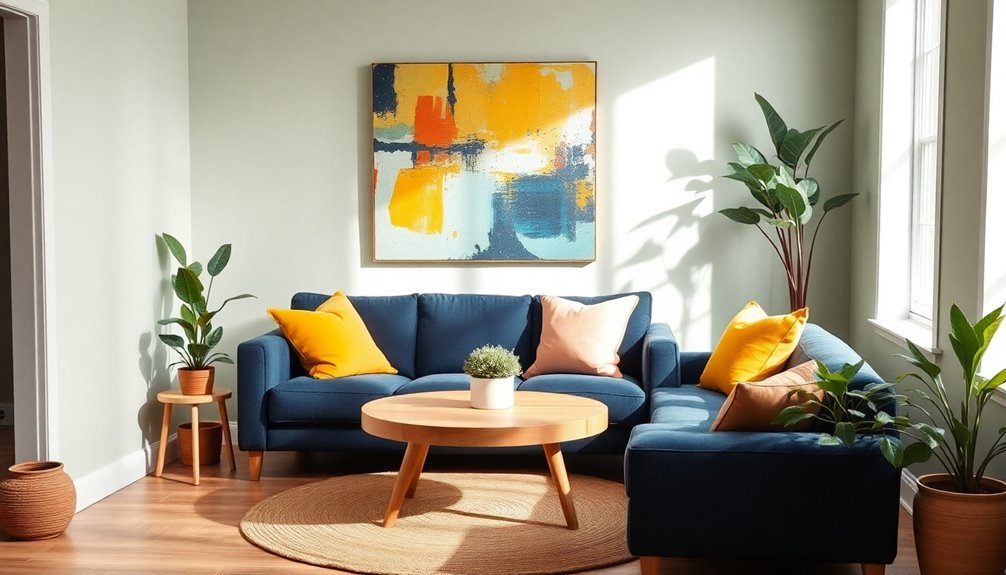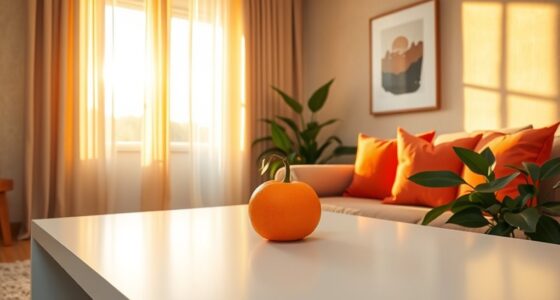For small living rooms, light and airy color combinations can make the space feel larger. Use soft pastels or off-whites to reflect natural light. If you want to energize the room, integrate bold accents like Raspberry Blush or Cool Aqua. Neutral bases paired with vibrant highlights, or even darker shades for depth, can create a cozy atmosphere. Accent walls also work wonders for visual expansion. Explore more ideas to enhance your small living room's charm.
Key Takeaways
- Use light and airy color combinations like soft pastels and off-white hues to create a spacious feel in small living rooms.
- Incorporate bold accent colors to energize the space, using striking shades for focal points and vibrant decor.
- Establish neutral bases with soft whites or light grays, then add personality through colorful cushions, artwork, or rugs.
- Create depth by using darker shades for accent walls, which can enhance character without overwhelming lighter elements.
- Opt for harmonious color palettes with smooth transitions to promote a connected and inviting atmosphere in small living spaces.
Light and Airy Combinations for Small Spaces
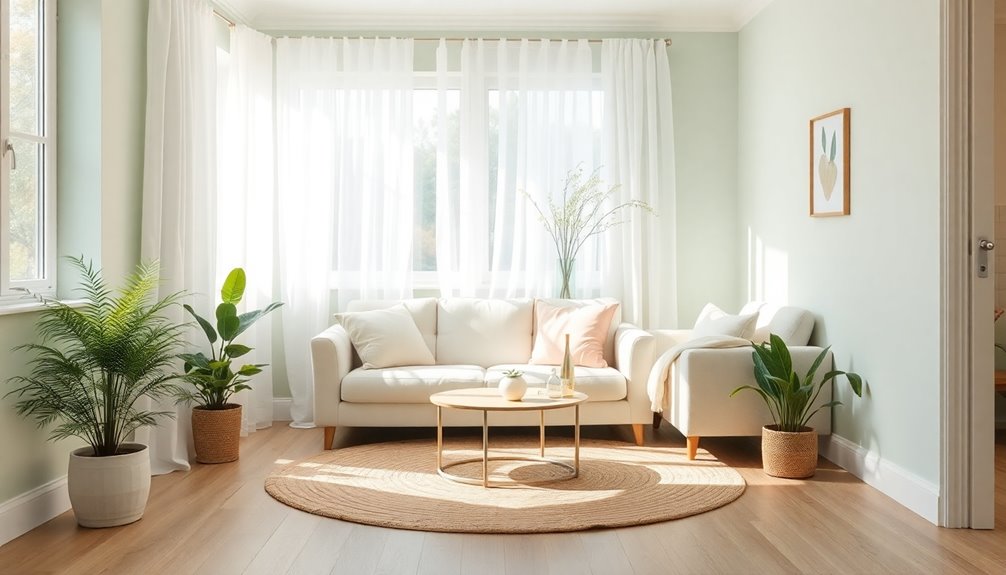
When you're looking to make your small living room feel more spacious, light and airy color combinations are your best bet. Soft pastels like Cloud Nine 2144-60 or Hint of Pink 884 can create an expansive atmosphere.
Off-white hues, such as Cloud Cover 855 and White Dove OC-17, reflect natural light, enhancing the airy vibe. Consider a two-tone color scheme, using a soft wall hue paired with a lighter ceiling to visually elevate the space and define areas.
Cool undertones like Aegean Teal 2136-40 can add calmness while keeping the lightness. Painting walls and ceilings the same light color creates a cohesive look, allowing the eye to flow effortlessly, making your small spaces feel open and inviting.
Bold Accents to Energize Your Living Room
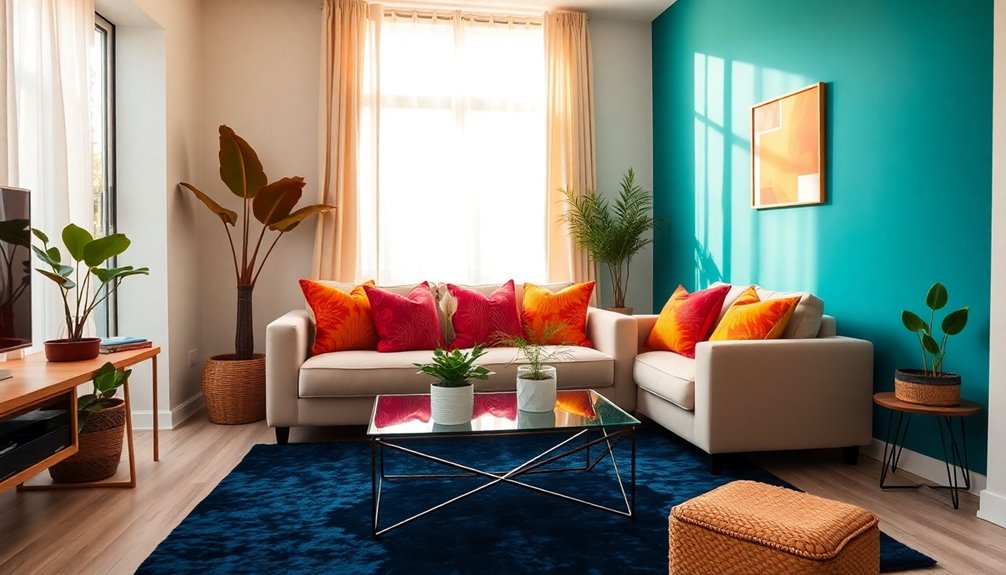
To energize your small living room, consider incorporating bold accent colors that draw the eye and create a vibrant atmosphere. Colors like Raspberry Blush or Cool Aqua can serve as striking focal points, infusing your space with life.
Deep hues such as Ming Jade or Savannah Green enhance coziness while making a dramatic statement. You can also create accent walls using contrasting shades, like Pale Sea Mist paired with Deep Ocean, to visually expand your small space and add depth.
Don't forget bright accent pieces like pillows or artwork in vibrant colors to complement neutral walls. Mixing bold and pastel colors, such as Misty Blush with soft neutrals, adds layers of interest while keeping the room inviting. Incorporating neutral color palettes can help balance the bold accents and create a more harmonious feel in the space.
Neutral Bases With Vibrant Highlights
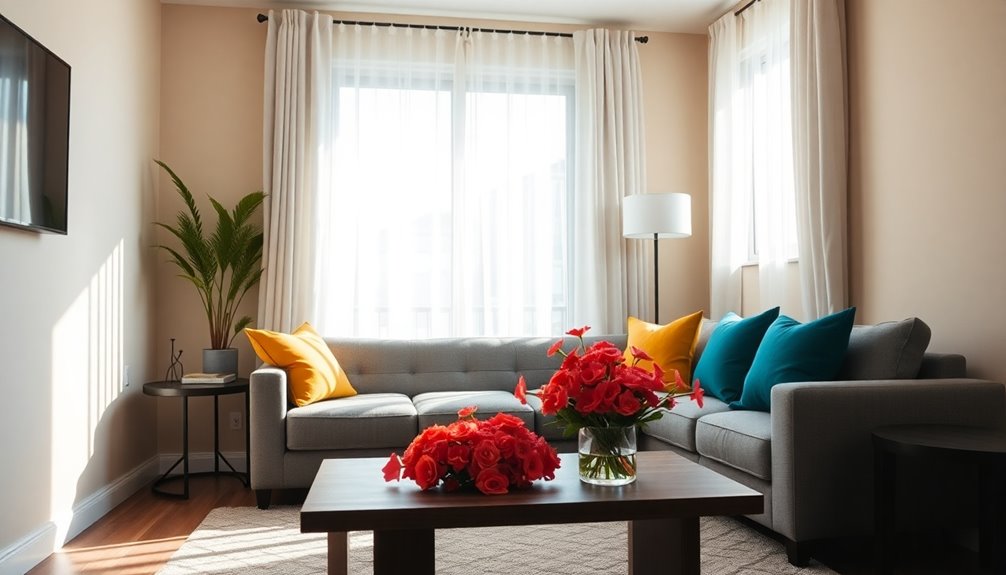
Creating a vibrant living room doesn't always mean overwhelming the space with bold colors. Instead, you can establish neutral bases like soft whites, greiges, or light grays to create an airy foundation in your small living rooms. This approach makes the area feel more spacious and inviting.
To add personality, incorporate vibrant highlights through accent pieces like cushions, artwork, or a statement rug in bold colors such as coral or teal. Consider a two-tone color scheme, with neutral walls and a striking ceiling color to draw the eye upward.
Rich jewel tones like emerald green or sapphire blue can also enhance visual depth without overwhelming the space. This balanced palette reflects your personal style while maintaining a cohesive look. Additionally, the incorporation of natural elements can further promote tranquility in your living area.
Creating Depth With Darker Shades
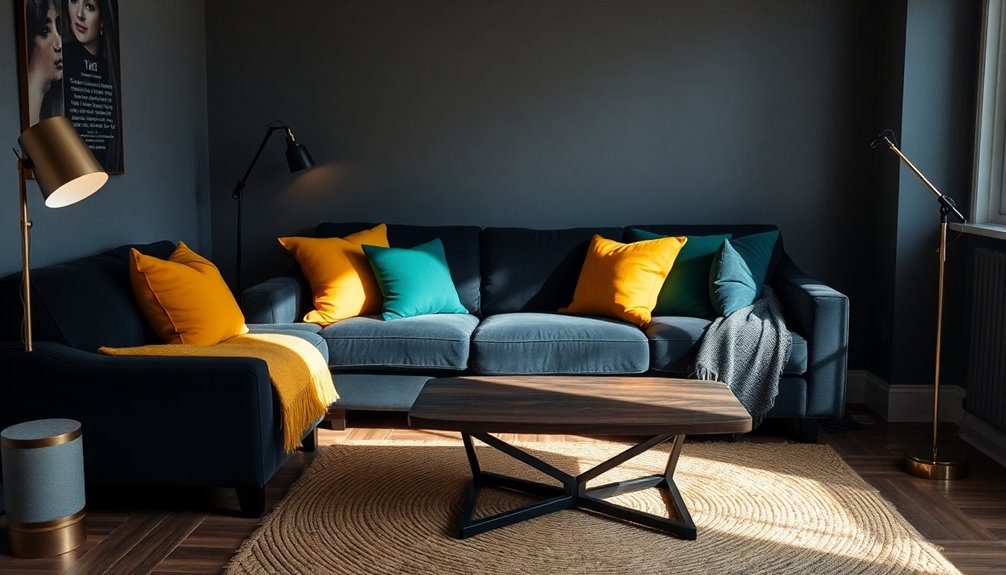
While many might shy away from darker shades in small living rooms, these hues can actually enhance the space's depth and character.
Using a darker color like navy blue or charcoal gray on one accent wall can make your walls appear to recede, creating an illusion of more space. Keeping other walls lighter draws the eye to that focal point, adding interest without overwhelming the room.
Plus, incorporating darker shades in ceiling treatments helps unify the space, enhancing its perceived height.
Pairing these deeper hues with lighter furniture and decor creates a striking contrast, emphasizing the depth while maintaining an airy feel. Incorporating natural materials can also help balance the darker tones and add warmth to the overall design.
Embrace darker shades to transform your small living room into a cozy, inviting retreat.
Harmonizing Colors for a Seamless Look

Darker shades can set an enchanting tone in small living rooms, but to enhance that charm, harmonizing colors is key.
Start with a unified color palette, where your walls, ceilings, and trim share similar tones. This creates a seamless effect that enhances the perception of space.
Consider a soft, neutral base like light gray or off-white, which can be beautifully accented with deeper shades for added depth without overwhelming the room.
A monochromatic scheme works wonders, using various shades of a single color to visually expand your living area while maintaining a cohesive look.
Remember to guarantee smooth color shifts between rooms to enhance overall harmony, making your small living space feel more connected and inviting.
The Impact of Accent Walls in Compact Areas

Accent walls can transform your small living room by creating a striking focal point that accentuates your favorite features or artwork.
By choosing a bold color, you not only introduce dynamic contrast but also shift the perception of space, making it feel larger and more inviting.
With the right hue, your compact area can radiate personality while still maintaining a cohesive look.
Focal Point Enhancement
Creating a focal point in a small living room can greatly enhance its design, and one effective way to achieve this is through the use of an accent wall.
By choosing rich hues, you can create visual interest that draws the eye and makes the space feel inviting. Here are three ways an accent wall can enhance your living room:
- Highlight architectural features: Use an accent wall to emphasize windows or doors, maximizing natural light.
- Define spaces: Select a contrasting color against lighter walls to create multifunctional areas.
- Add personality: Incorporate patterns or textures on your accent wall to transform the room into a cozy retreat.
This strategic element can dramatically elevate your small living room's overall aesthetic. Additionally, ensuring that the height difference between furniture is appropriate can further enhance comfort and style in the space.
Color Contrast Dynamics
When it comes to maximizing the visual appeal of a small living room, color contrast plays a pivotal role in how space is perceived. Accent walls can create a striking focal point, drawing the eye and making the room feel more dynamic. By using deep hues like jewel tones, you add drama and sophistication, enhancing the atmosphere of compact areas.
Two-tone color schemes offer a smart way to delineate multifunctional spaces, giving your room a structured appearance. An accent wall can also highlight architectural features or artwork, providing depth and dimension that small spaces often lack.
Additionally, the strategic use of accent colors fosters flow and continuity, making your living area feel cohesive and well-designed.
Spatial Perception Shift
While you might think small living rooms limit your design options, incorporating an accent wall can greatly alter spatial perception. A bold color can create a stunning focal point, drawing the eye and adding depth to your compact space.
Here's how an accent wall can transform your room:
- Defines Areas: Highlight specific features like windows or art, helping to delineate multifunctional spaces.
- Enhances Height: Darker shades can make ceilings feel taller, especially when paired with lighter adjacent walls.
- Expands Visual Space: Contrasting a bold accent wall with lighter colors creates an illusion of more space. Additionally, using eco-friendly practices like burning only dry, seasoned firewood can enhance the overall atmosphere of the room by promoting better indoor air quality.
Frequently Asked Questions
What Is the Best Color for a Small Living Room?
When choosing the best color for your small living room, consider light shades that create an airy feel.
Soft neutrals like light grays or whites can make the space feel larger and more inviting.
You might also think about accent walls in bolder hues to add a focal point without overpowering the room.
Ultimately, pick colors that resonate with you and reflect the mood you want to create in your cozy space.
What Color Makes a Small Room Look Bigger?
Imagine stepping into a serene oasis where space unfolds like a gentle breeze.
To make a small room look bigger, you'll want to embrace light colors—off-whites, soft pastels, and cool hues like blues and greens. These shades create an airy atmosphere, tricking the eye into perceiving more space.
Consistent palettes for walls and ceilings enhance this illusion, while reflective finishes add depth, inviting light to dance and expand your cozy retreat.
What Colors Are Best for Small Rooms?
When you're choosing colors for small rooms, light shades like off-whites and pastels can really open up the space, making it feel more expansive.
If you're looking for depth, try deep hues like navy or forest green; they add character without overwhelming.
You might also consider two-tone schemes to define areas or vibrant accent walls to create focal points.
Sampling paint in different lights will help you find the perfect shades for your room.
What Color Is Replacing Gray?
You'll notice that warm earthy tones, like terracotta and beige, are replacing gray in many spaces.
These colors create a cozy atmosphere that invites comfort.
Soft greens and muted blues also offer a fresh look, providing a calming backdrop for your decor.
Rich jewel tones, such as deep emerald and sapphire, add drama, while light pastels bring brightness and a sense of openness.
Embracing these colors can truly transform your living environment.
Conclusion
Incorporating the right color combinations can transform your small living room into a vibrant oasis or a serene retreat. By balancing light and dark shades, or introducing bold accents, you create a space that feels both inviting and dynamic. When you harmonize your colors, you not only enhance the room's aesthetic but also craft a unique atmosphere that reflects your personality. So, embrace these color strategies and watch your compact area bloom into a delightful haven that surprises you daily.
